Wild West
United States
__________________
Private Photo Tours
for
Individual & Small groups
________________
Exclusive Locations
into The Great Wild West
Discover secrets photographics spots with us, we offer an exclusive photo tour into the west USA: California, Utah, Nevada, Arizona. trough unique and exclusive locations for an autenthic photographic journey
The west USA rappresent one of the best location in America for all landscape photo lovers with surreal photographic spots for the joy of all photographers. This magic part of the earth deserves to enjoy this photographic tour every day in a different place absorbed into its wonderful landscape.
ARIZONA
CALIFORNIA
NEVADA
UTAH
the Highlights of the
Photo lovers Need
EXCLUSIVES PHOTOGRAPHY LOCATIONS
All ours photographics tours in west USA are off the beaten touristics locations where we will drive off road to lead you to the most exclusives photography spots.
PRIVATE PHOTOGRAPHIC TOURS
You can choose your period and the departure dates. We offer private photograhic tours working exclusivly with a small groups that starts with 2 persons only. This is the best way to enjoy and be concentrated in your photographic experience, taking your time for each shoot when the light is at it's best
EQUIPPED 4X4 VEHICLES
all of ours photographic tours in west USA will be leaded by our professional guide on board of 4x4 vehicles ensuring comfort and freedom of move during all the trip.
PHOTOGRAPHIC ASSISTANCE
You will enjoy the professional assistance of a professional photographer that will lead you during the whole photographic tour in USA and thanks to him reach the most exclusive photographic spots with the purpose to realize prestigious images,
WHERE TO STAY
We love to be in a comfort places, the accommodations are on your decision, you can choose wich kind level of hotel, but remember that the decision depending also on the availability of the place, for this reason sometime it is absolutly not possible and we prefer to get our goal, it means amazing images.
The first reason and motivation of our photographic tour is to give you the opportunity to shoot sensational images; to get it is very important to be in the right place with the best light, that's why most of the time we must choose to overnight in the middle of the scene instead to stay in a far away hotel. Its mean that if we don't have other chance we must use a mobile tented camp.
THE BEST LIGHT
The first rule to realize a good photography is to follow the light. Be in the right place and in at the right time there, exactly where there are the images to hunt.The images are already there, are you that must be there in the right moment. This is what we are following for and this is the first step to found it.
Most of the time we set-up our tents, each time in strategic and exclusive photographic locations, it able us to be in the right place during the first light of the sunrise and the last light of the sunset.
.
Full Landscape Photo Tour
Amazing Usa Photographic Road Trip, discovering the parks of Wild West in the United States… in our photographic journey we will travel the hottest kilometers you have ever tasted, We will discover the West part of the United States and its most famous Parks, the Mojave Desert, the Red Canyon with its fiery red Hoodoos (fairy chimneys) in the Goblin Valley, Arches National Park with the particolar Delicate Arch and Canyonlands with the Dead Horse Point, the Mesa Arch and the Monument Valley, the Horseshoe Bend and Antelope Valley, the magnificent Grand Canyon and the Death Valley…. but not only, we have more routes with exclusive photography locations.
Exclusive photo spots
As everybody knows, the west USA as California, Nevada, Utah, Arizona are famous tourist destinations and full of people but we have created a special adventure throught exclusive routes off the tourist beaten tracks, diffferents from other traditional tours. Becouse we want to offer the best photo tour for our travellers. We use 4x4 vehicle to reach the best locations and discover the wild USA soul. A professional guide and photographer will lead you into the most beautiful places for the photo tour focused in photographic landscapes. During this photographic journey we will shoot many locations every day, for this reason we consider the Wild West one of the best photographic destinations in the world.
This photo tour in USA will let you shoot many different images with interesting contrasts...this is what you, photographer, are looking for.
Wild West USA
-
exclusive
photo tour
reaching
secret locations
.
Discover our photographic trip
that we organize in Arizona, California, Nevada, Utah,
reaching exclusives photographic locations
Antelope Canyon
Antelope canyon is the most visited canyon in the south west states. It is located on the ground Navajo near Page in Arizona. Here you will find unique landscapes, surreal colors and wild nature. In spring you can find yourself in the middle of expanses of poppies thanks to its special microclimate that favors its growth…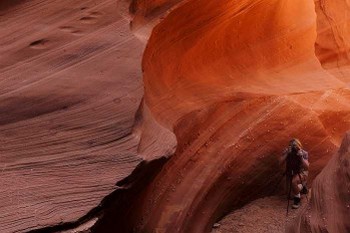
This Canyon was formed over millions of years by the erosion of sandstone by water and wind. It consists of two separate formations. The Rift that generated the two Canyons find a first barrier, on its way to Lake Powell, consisting of a formation of Sandstone placed transversely.
Here it generates the Upper Antelope Canyon, 270 meters long, proceeding towards the lake to the north, the erosion penetrates the ground gene rating the longest and least smooth Lower Antelope Canyon over 4 kilometers long.
Both Canyons are a wonderful challenge for photographers due to the difficult light conditions. It is perhaps the most photographic site in northern Arizona. During our photographic sessions we are going to photograph the vertiginous shapes of its walls, shaped by atmospheric agents, which the light gives splendid brilliant chromatic tones ranging from yellow to orange to red and purple, which make it a unique show, among the most evocative of the Usa Parks. In our fully guided photographic tour, a photography teacher will help you manage the logistics of the shoots so you can concentrate on the technique to create unimaginably magnificent photos.
Horseshoe Bend
A stone's throw from Page, 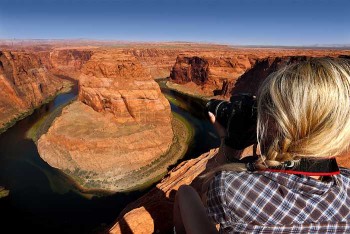 in the Glen Canyon National Recreation Area rises this hidden gem, a particular meander of the Colorado River, the same that crosses the Grand Canyon, which offers a magnificent view of nature, a large loop in the shape of a "horseshoe" carved by the river.
in the Glen Canyon National Recreation Area rises this hidden gem, a particular meander of the Colorado River, the same that crosses the Grand Canyon, which offers a magnificent view of nature, a large loop in the shape of a "horseshoe" carved by the river.
In an exciting phographic workshp from the dizzying height of the observation point (a jump of over 340 meters below your feet) we will be offered the amazing spectacle of the emerald backdrop in contrast with the soft red of the rocks,
Monument Valley Tribal Park
Desert plateau (Colorado Plateau) of river origin, the landscape is characterized by rocky pinnacles, geologically called "witnesses of erosion", famous all over the world as icons of the "West".
The Natives call this place "Tsé Bii Ndzisgaii", which means "the valley of the rocks". Just as represented by the name the site is made of huge rocks and pinnacles that rise from the bottom like stone castles. The red and orange sandstone rock creates breathtaking contrasts with the intense blue of the sky.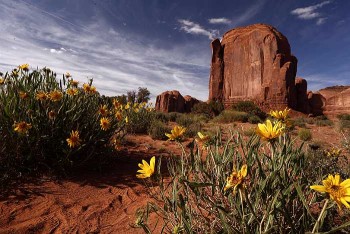
The monuments of the United States are in nature and the America-Nature combination finds its expressive peak in Monument Valley. One of the most Majestic and most photographed points on earth, this large valley boasts masterpieces of sandstone that tower at heights of 340 meters, framed by spectacular clouds that cast their shadow giving reflections and nuances that make this landscape, together with the dimensions of this disarming vastness, an overwhelming beauty. Located between the states of Utah and Arizona is the Navajo Indians Nature Reserve. Along the way our photo tour takes us to see East and West Mitten, Merrick Buttes, Elephant Butte, The Three Sisters, Totem Pole, Artist's Point and the legendary Jhon Ford's Point.
Grand Canyon
The Grand Canyon is a huge gorge created by the Colorado River in northern Arizona. 446 km long, up to 1,857 meters deep, approximately 29 km wide. Almost two billion years of earth's history have come to light thanks to the erosion of the rocks by the Colorado River and its tributaries and thanks to the lifting of the Colorado Plateau.
This long cut makes visible layers of rock from the Proterozoic and Paleozoic periods. Lifting the mountain building associated with plate tectonics caused the sediment to rise to hundreds of meters, creating the Colorado Plateau area. The Grand Canyon is located within the homonymous National Park which extends for 4,927km².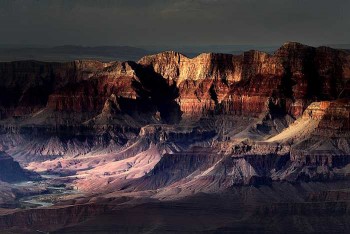

Certainly the most fascinating and even the most exciting way to visit the Canyon is to fly over it in a helicopter.
The photo travel includes the choice of the slope: the South Rim or the North Rim. Choosing the South Rim there are numerous observation points along the edge, including Desert View, Buggeln, Grandview Point, Mather Point (where the visitor center is located), Yavapai Point, Hopi (particularly beautiful at sunset), ShoshonePoint and Hermits Rest, Bright Angel and Eagle Point, the Desert View Watchove.
The North Rim is quieter, higher and exposed, but also less accessible than the South Rim. On the north side there is the possibility of doing many walks and the most fascinating views can be seen along the paths Bright Angel Point (the easiest), Widforss, Cape Royal and the legendary North Kaibab.
The Wave
Within the incredible area of the Coyote Buttes, if fate will be our friend and we will be drawn, we will have the opportunity to visit this "iconic place", which ideally summarizes the best that can be found from the photographic point of view in the Colorado Plateau, as a gift offered to minds and eyes ready to grasp.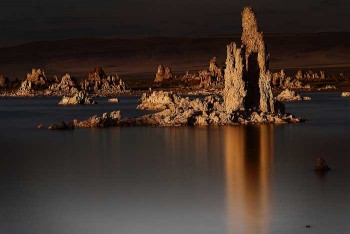
We will admire, in this phographic travel, a formation of rare beauty, a wave carved into the rock whose colors will be so clear as to give our photos breathtaking beauty. The view is unforgettable.
Bryce Canyon
Beautiful fairy-tale Bryce Canyon, with its unmistakable golden peaks, not found in any other gorge or valley in the United States. A fairy landscape of the Bryce Canyon National Park, formed by a wide valley from which the Hoodoos, the pinnacles that look like sand castles rise.
Located within the homonymous National park in the southwest of the United States, in the State of Utah, Bryce Canyon is a huge amphitheater originating from the erosion of the eastern sector of the Paunsaungt Plateau. It is famous for its characteristic red-orange pinnacles, called Hoodoos, very special rock formations shaped by millennia of rain and winds, that we are going to observe and immortalize du ring our photographic workshps. This rock forest is a place of great scenic effect, because the red earth literally lights up at sunrise and sunset, making the visionof the landscape surreal and dreamlike.
It is possible to spot numerous mammals, although it is a perfectly desert area formed with the relatively lush rainfall ecosystems, in which the Prairie Dogs, squirrels, mountain lions, pronghorn sheep, coyotes, gray foxes ... California Condor, Clark's Nutcracker and the famous Peregrine Falcon.
Death Valley
This amazing photographic raod travel takes us in California, on the border with Nevada we will find the Death Valley, whose area is a National Park and whose central point of reference is Furnace Creek. Despite the un-encouraging name, this marvelous park is a jewel of nature, with its arid and desert landscape, with its ancient lakes, by now evaporated, its undulating mountains with a thousand layers of colored sediments. Death Valley is really vast! It is the hottest place in the United States, temperatures range from 45 to 56 degrees Celsius (117 / ... degrees Celsius!) In this basin below sea level, the summer heat and record drought make the Death Valley a land of extremes…..but yet, every extreme has a surprising contrast. The towering peaks are covered with winter snow. Rare rain storms give life to vast fields of wild flowers. The lush oases are home to small fish and a refuge for wildlife and humans. Despite its ominous name, a great variety of life survives in Death Valley. These are the main points we are going to visit during our photographic journey:
- Mesquite Flat Sand Dune
The dunes of the Sahara seem to have moved to the American West: soft hills of fine white sand. At dawn and at sunset, the landscape is even more impressive...this is the right time for our photographic sessions.
The dunes of the Sahara seem to have moved to the American West: soft hills of fine white sand. At dawn and at sunset, the landscape is even more impressive...this is the right time for our photographic sessions.
- Zabriskie Point
Here, the rock seems to foam. Formed by sediments generated by the ancient Furnace Creek which no longer exists and which previously occupied the Death Valley, Zabriskie point offers visitors an unreal naturalistic scenario, ideal for lanscapes photography. The compounds of saline mud and gravel together with the lapilli of the nearby volcanoes have shaped a harder layer of lava over time: the orogeny has then created the spectacle that today welcomes visitors. The place is named after Christian Brevoort Zabriskie, director in the first half of the twentieth century of the Pacific Coast Borax Company, a borax extraction company, the mineral present in the Furnace Creek area. This particular point of Death Valley is a must-seen.
- Badwater
Basin south of Furnace Creek is the lowest point in the United States, reaching 86 meters below sea level. It is a vast salty residue of the immense prehistoric Manly lake that once covered the valley. Located in the Furnace Creek area and 86 meters below sea level, it is conventionally referred to as the lowest point in North America. It is a basin where water evaporates forming salt polygons and represents one of the most characteristic places of the Death Valley with these blocks of salt that create particular chromatic effects in reflecting the lights of dawn and sunset. You will certainly appreciate the magic of this place.
-Dante's View
In Death Valley there is a strange phenomenon called "rolling stones" or walking stones. On the big dried-up lakes you can see huge stones followed by long tracks that make paths almost at right angles that suggest that the moving rocks have actually walked. For centuries it has been a real headache for scientists, until, last year, a group of scholars filmed the race of some of these boulders that are found in particular on the Racetrack Playa in the Death Valley. To push the stones on the flat surface of the Playa would be the thin layers of ice that form in this place, when the dry lake bed fills with rainwater. When the ice breaks on a sunny day, the ground will crack producing noises from broken glass and the boulders move.
- Mesquite Flat Sand Dunes
In the area of Stovepipe Wells we find this extraordinary spectacle of sand dunes surrounded by mountains. The best time to visit this endless dune is dawn or dusk when the light manages to create a golden glow.....and then we will be there...to take wonderful pictures!
Yosemite
Defined by the legendary naturalist John Muir as the "incomparable valley", Yosemite National Park is the icon of America's majestic natural beauty.
It is a valley, located in the western part of the Sierra Nevada, whose formation dates back to the ice age and is famous for its natural beauty such as spectacular waterfalls, giant sequoias, towering cliffs and rich wildlife. A real paradise for the naturalistic photography!
The valley rises to 1,200 meters above sea level about 240 kilometers east of San Francisco and extends from east to west. Crossed by a dense network of streams and creeks and numerous waterfalls (Yosemite Falls, Tenaya Creek, Illilouette, Bridalveil Creek and Bridalveil Falls are just some of these natural attractions) that flow into the Merced which in turn flows into the Pacific Ocean, is surrounded by a dozen ancient peaks of 114 million years essentially consisting of cliffs and rugged granite peaks, up to 1,000 meters high such as the Half Dome, El Capitan, the Three Brothers and Mount Lyell, which is the highest peak.
The majestic view from the Glacier Point, an impressive granite cliff 2,199 meters high that descends to the Yosemite Valley, belongs to the most important points of interest of the park along with Half Dome, Clouds Rest, Liberty Cap, Vernal Fall, Nevada Fall and the nearby Alta Sierra. Today it is an indispensable point to take memorable photographs. The view of Half Dome, North Dome and the Merced River canyon in the setting of this refuge is unforgettable. The best time is the sunset, when the Half Dome turns pink.
Among Yosemite's numerous reasons of pride, the falls of fire are among the main ones. Yosemite Valley conquers three locations among the twenty highest waterfalls in the world, with Yosemite Falls, Sentinel Fall and Ribbon Fall. Yosemite Falls is by far the highest waterfall in North America. Dense is the vegetation consisting of forests and pine forests and crossed by internal paths suitable for walks that lead to heights at higher altitudes from which you can enjoy panoramic views of great beauty, such as the Wawona Tunnel, a starting point for the naturalistic and landscape photography . In addition to natural beauty, in this amazing photo-journey we are going to try to photograph also American black bears, moose and striped squirrels that live in Yosemite Valley.
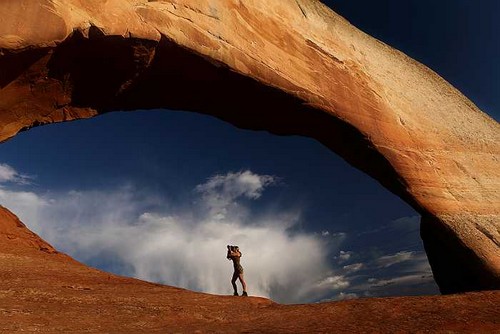
Arches National Park
Visiting Arches in our photojourney we will discover a landscape of contrasting colors, terrestrial forms and textures different from anywhere else in the world. The park has over 2,000 natural stone arches, huge pinnacles and giant rocks. This red rock wonderland will inspire us with its formations and its sunsets. These are the most spectacular and interesting points:
- Park Avenue Viewpoint
The walls of this canyon reminded of early city buildings in big city street. Beyond the viewpoint, the trail descends steeply into the spectacular canyon and continues to Courthouse Towers. We will walk among massive monoliths and towering walls and views of the nearby La Sal Mountains.
- Balanced Rock
One of the most iconic features in the park, stands a staggering 128 feet (39m) tall. While this formation may appear to be an epic balancing act, it’s actually not balanced at all. The slick rock boulder of Entity Sandstone sits attached to its eroding pedestal of Dewey Bridge mudstone. The exposure of these two rock strata are ideal for the formation of arches and balanced rocks.
- Thrilling Beauty
The Windows Section is considered by some to be the beating heart of Arches National Park. The area contains a large concentration of arches and is one of the most scenic locations in the park that we are going to photograph. North Window, Turret Arch, and Double Arch are just a few of the awe-inspiring expanses you find in just over two square miles. Other features in this area include Garden of Eden, Elephant Butte, and Parade of Elephants. -Devils Garden located at the end of the park is one of the premier locations in the park. Here you will find archives, spheres, and a large concentration of narrow rock walls called “fins.” Forms when rainwater erodes parallel fractures caused by the uplift of salt deposits below the surface Fins eventually erodes and give way to the formation of arches like Landscape Arch, the crown jewel of Devils Garden.
Mesa Verde
To understand more about Native Americans, nothing better than visit Mesa Verde: it will lead to a detour from Moab but the mountain scenery is magnificent, completely different from the arid one of Canyonlands and the ruins of the native communities, hidden in the canyons .
The park extends over a series of Mesa, the hills with steep sides and practically flat tops (similar to parallelepipeds) typical of the Colorado Plateau and its incredible erosion phenomena that give the visitor a variety of forms (mesas, butts, canyons, hoodoos, arches, just to mention the main ones) that is unbelievable. The Mesa Verde National Park is a protected area of the United States and a UNESCO World Heritage Site. It is the second oldest American park after Yellowstone. It is located in the state of Colorado, in the county of Montezuma, in the south-western part, it was established in 1906 and has an area of 210 km2. There are the remains of numerous settlements built by the ancient Ancestral Peoples, once called Anasazi. These are villages built within recesses in the rock, called cliff-dwellings, and although the oldest settlements in the park date back to no more than 800 years ago, the region was inhabited as early as the 6th century. The park takes its name from the dense pine and juniper forests. It is archeological heritage of the Ancestral Pueblo people.
These sites are some of the most notable and best preserved in the United States. The constructions were made with a mixture of clay, sand and sun-baked straw: all abundant raw materials in the area, which the natives knew how to wisely mold, obtaining complex and difficult-to-make shapes such as the Kiva, the underground ritual rooms and the houses with 2 or 3 floors. What makes the pueblo of the Mesa Verde unique is their location, spectacular and extremely functional. They are found in the large caves and recesses that open onto the main canyons, and to reach them one must descend through narrow paths from the overlying mesa.
Canyon de Chelly National Monument
Within the Navajo Indian Reserve, in the county of Apache, it rises in the immense natural scenery of Arizona's red earth, a little-known canyon that seems to compare, both in terms of beauty and capacity of suggestion, with the famous parks of Monument Valley and Grand Canyon. We are talking about Canyon De Chelly National Monument, a protected natural area of about 340 square kilometers located in the Apache County, North East of Arizona, established as a National Monument of the United States in 1931. The Canyon De Chelly, fully inserted in a Navajo reserve, has a decidedly majestic appearance, with its 2 sheer cliffs of sandstone rising steeply, forming imposing cliffs up to 300 meters high. Deep in the canyon it is easy to see the Chinle Wash river, surrounded by unusual vegetation and the spectacular secular settlements of the ancient anasazi (which among other things also found in the Mesa Verde park) set directly into the rocky walls. The Canyon de Chelly, formed in turn by two canyons (the Canyon del Muerto and the Monument Canyon), branches out into a series of numerous and smaller canyons, suggesting, in its intricate form, a veritable maze of over 40 km.
The edges of the canyon offer a succession of spectacular views thanks to the 10 viewpoints that follow one another on South Rim Drive and the North Rim Drive.
West USA
Photo Tour
-
We will organize your private photo trip
realizing your best shot ;-)
.
BEST SEASON
For a photographer, the best season to visit West Usa, Arizona, California, Nevada and Utah is from May to September with more light contrasts.
EXPERIENCE | DIFFICULTY
- Beginner, amateur, enthusiast and semi-pro and pro photographers (non-photographers also welcome)
- adventure / long travel
INCLUDES
landscape phtography workshop
Professional photographer | guide
4x4 Adventure
TRANSFERS
Arrival Airport: Los Angeles - Transfer time to the 1° hotel 1.30 h
Departure Airport: Las Vegas - Transfer time from the last point 5.15 h
Our photo tour begins at 11 AM on the first day and ends at afternoon on the last day.
TRAVEL VISA
A visa may be required depending on your nationality. Go to www.projectvisa.com for more information.

